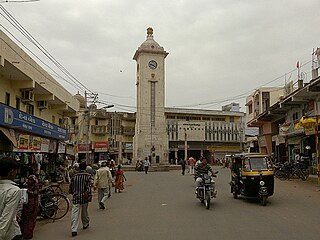
Lothal was one of the southernmost sites of the ancient Indus Valley civilisation, located in the Bhal region of the Indian state of Gujarat. Construction of the city is believed to have begun around 2200 BCE.

Saurashtra, also known as Kathiawar, is a peninsular region of Gujarat, India, located on the Arabian Sea coast. It covers about a third of Gujarat state, notably 11 districts of Gujarat, including Rajkot District. It was formerly a state of India before it merged with Bombay state. In 1961 it separated from Bombay and joined Gujarat.

The Sabarmati river is one of the major west-flowing rivers in India. It originates in the Aravalli Range of the Udaipur District of Rajasthan and meets the Gulf of Khambhat of Arabian Sea after travelling 371 km (231 mi) in a south-westerly direction across Rajasthan and Gujarat. 48 km (30 mi) of the river length is in Rajasthan, while 323 km (201 mi) is in Gujarat.

Sabarkantha district is one of the 33 districts of Gujarat state of India, it is located in the northeastern part of the state. The administrative headquarters of the district are located in Himatnagar.

Khambhat, also known as Cambay, is a city and the surrounding urban agglomeration in Anand district in the Indian state of Gujarat. It was once an important trading center, but its harbour gradually silted up, and the maritime trade moved to Surat. Khambat lies on an alluvial plain at the north end of the Gulf of Khambhat, noted for the extreme rise and fall of its tides, which can vary as much as thirty feet in the vicinity of Khambat. Khambat is known for its halvasan sweet, sutarfeni, akik stone and kites (patang), and for sources of oil and gas.

Mewar or Mewad is a region in the south-central part of Rajasthan state of India. It includes the present-day districts of Bhilwara, Chittorgarh, Pratapgarh, Rajsamand, Udaipur, Pirawa Tehsil of Jhalawar District of Rajasthan, Neemuch and Mandsaur of Madhya Pradesh and some parts of Gujarat.

Ahmedabad district comprises the city of Ahmedabad, in the central part of the state of Gujarat in western India. It is the seventh most populous district in India.

Bahraich district is one of the districts of Uttar Pradesh state of India, and Bahraich town is the district headquarters. Bahraich District is a part of Devipatan Division.

Anand District is an administrative district of Gujarat state in western India and whose popular nickname is Charotar. It was carved out of the Kheda district in 1997. Anand is the administrative headquarters of the district. It is bounded by Kheda District to the north, Vadodara District to the east, Ahmedabad District to the west, and the Gulf of Khambhat to the south. Major towns are Umreth, Khambhat, Karamsad, Tarapur, Petlad, Borsad and Sojitra.

Western India is a loosely defined region of India consisting of western states of Republic of India. The Ministry of Home Affairs in its Western Zonal Council Administrative division includes the states of Goa, Gujarat, and Maharashtra along with the Union territory of Dadra and Nagar Haveli and Daman and Diu, while the Ministry of Culture and some historians also include the state of Rajasthan. The Geological Survey of India includes Maharashtra but excludes Rajasthan whereas Ministry of Minority Affairs includes Karnataka but excludes Rajasthan.

Maletto is a comune (municipality) in the Metropolitan City of Catania in the Italian region Sicily, located about 140 kilometres (87 mi) east of Palermo and about 40 kilometres (25 mi) northwest of Catania.

The Bhal region is an area of Gujarat, India. It is spread across the political boundaries of the districts of Bhavnagar, Ahmedabad, and Anand. The Bhal region is situated on the deltas of the Sabarmati, Bhogawo, Bhadar, Lilka and other rivers that flow east and southeast off the Kathiawar peninsula into the Gulf of Cambay. The word Bhaal seems to have been derived from the Sanskrit word भाल which means forehead. Such a name is given to this region probably because it is mostly as flat as a forehead with almost entire region's soil without any stones, pebbles or gravel.
Vadeli is a small village in Borsad taluka, Anand district, Gujarat, India. It is located around 8 km from Borsad. It is surrounded by the fertile Charotar region which largely produces tobacco, rice, cotton, lady finger, Tomato, Potato and other agricultural crops. PATEL owns the majority of business, majority of Patels are from 60 house community that dominates Amul Sahkari Madali Milk Dairy and Patel bazar. Other major communities are Darbar, Thakor, Brahmins and Christians. Gandhiji passed through Vadeli Patiya in Dandi March satyagrah, Borsad satyagraha.
The Architecture of Gujarat consists of architecture in the Indian state of Gujarat.
Dholera Special Investment Region (DSIR) is a greenfield industrial planned city near Dholera in Gujarat's Ahmedabad district, around 100 kilometers to the south-west.spread over more than 920 km2 it is a new industrial city being jointly developed by the Government of India and Gujarat. Dholera is strategically located, well connected with trade gateways and falls in the influence zone of proposed Delhi – Mumbai Industrial Corridor project (DMIC), a joint initiative by the Government of India and Japan.
Amreli Taluka is a prominent administrative division situated in the Amreli district of the Indian state of Gujarat. As an integral part of the region, it holds historical, geographical, and cultural significance.
Dhari Taluka is a geographical subdivision located in the western Indian state of Gujarat, situated in the Amreli district. Dhari Taluka encompasses a diverse range of topographical features, cultural nuances, and economic activities that contribute to its unique identity. Dhari is the headquarter of the taluka.
Babra Taluka is a sub-divisional administrative region situated within the Amreli district of the state of Gujarat, India.
Bagasara Taluka is a geographical subdivision located in the Amreli district of the state of Gujarat, India. It is situated in the western part of the country and falls within the Saurashtra region. Bagasara is the headquartes of the taluka.















